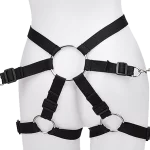The concept of “hysterical woman” is shrouded in Western history as a large-scale label that is both a diagnosis and a hateful label that controls women’s physical, emotional and sexual autonomy. From ancient medical theories to Freud’s psychoanalysis, from medieval witch hunting to contemporary descriptions in film and literature, hysteria has been seen as a means of pathological femininity, especially when it resists patriarchal norms. But where does this idea come from, and how does it shape the struggle for sexual autonomy, especially in feminist and queer discourse? An exploration of history, art, and sexuality will reveal the origins of hysteria, its implications, and the way women recycle narratives.
The roots of hysteria: From the wandering uterus to Freud’s sofa
The word “hysteria” originated in Greek Hitrameaning the uterus. This concept can be traced back to ancient Egyptian and Greek medicine, where people believe that a woman’s uterus can linger throughout the body, causing various physical and emotional obstacles. Hippocrates and later Galen Sexual deprivation is a major reason, and marriage and intercourse are stipulated as “cures”.
This idea was always experienced in the Middle Ages when the influence of the Catholic Church was reconceived as a sign of demonic property or divine punishment. Women who show strong emotions, sexual desire, or contempt are often seen as “own” and are subject to cruel exorcism, isolation or execution. The infamous witch hunting targets of the 15th to 17th centuries were many women who were independent, sexually autonomous, or simply inconvenient to patriarchy.
By the 19th century, hysteria had become the favorite diagnosis of Victorian doctors. Women are diagnosed with hysteria, neurological disorders and depression, essentially any deviant behavior Passive Feminine temperament. Jean-Martin Charcot, a famous French neurologist Strengthens the notion that women’s bodies are inherently unstable, dramatic, and require male intervention.
The rise of psychoanalysis
Sigmund Freud’s theory further reinforces the disease deep in sexual behavior with women. He believes that hysteria is derived from repressed sexual trauma or unfulfilled desire for sexual desire, which marks the transition from pure physical interpretation to psychological interpretation. His case study (most notably “dora”) focuses on young women who resist traditional sexual roles, framing their suffering because they cannot accept normative heterosexuality.
Freud’s work does help recognize women’s inner life, but it also The concept is strengthened that female sexual behavior needs to be decrypted, managed and corrected according to male authority. His notorious concept of “penis jealousy” further marginalizes non-configurational identities, refuting the notion that women may desire autonomy rather than merely desire to be a phary alternative.
Artistic and hysterical woman
Art History provides a fascinating shot through which to examine hysterical women. The 19th-century romance and pre-Raphaelite movements are fascinated by miserable melancholy women, who think Ophelia is drowned by the famous paintings of Millais, or the lange bug figures of Dante Gabriel Rossetti’s work. These women are often described as pale, fragile, on the edge of madness, strengthening Thoughts that passionate women are destined to ruin.
In the cinema, Trope evolved into a “hysterical woman” of horror and psychological thriller. From Charlotte Perkins Gilman Yellow wallpaper (1892) to Hitchcock dizziness (1958), the heroine expressing agent or misery is dismissed as unstable, unreliable or dangerous. The 1970s and 1980s brought about a reinterpretation of feminism, and the films were like Carrie (1976) and Cultivate heart (1979) Restored this terrible woman to a symbol of being suppressed and resisted.
Hysteria, feminism and queer cultivation
In the late 20th century, feminists and queer scholars began to challenge and retract the concept of hysteria. Hélène Cixous’s “Medusa’s Laugh” (1975) urges women to embrace their own “hysterical” voices, rejecting the linguistic and sexual constraints imposed by patriarchy. Similarly, Judith Butler’s work on gender performance proposes a framework for expressing certain femininity as excessive or unreasonable.
Queer history shows that hysteria is not only a tool for silence straight women, but also all non-conformational identifications of pathology. In the early 20th century, lesbians and gender-incompatible people were often institutionalized under the guise of neurological disorders, reflecting the treatment of “hysterical” women in the early days. The rise of radical queer movements in the 1960s and 1970s challenged this medicalization, requiring awareness of sexual autonomy in the rigid binary industry enforced by psychiatry.
The hysterical legacy of contemporary feminism
Today, the hysterical ghosts persist in the way women’s emotional and sexual autonomy. Women who express anger, desire, or boundaries are still labeled as “too much”, too emotional, harsh, too big. The weaponization of terms such as “crazy ex-girlfriend” or “dad problem” echoes historical attempts to refute the unreasonable experience of women.
However, the feminist and queer communities continue to postpone. Movements like #MeToo and Sex-positive Feminism have taken back the women’s narratives, validating the fabricated experience that has long been seen as hysterical. Similarly, modern queer discourse celebrates fluidity and diversity in gender and sexual expression, refusing to be bound by the historical conception of pathology.
Meanwhile, modern feminism struggles in the internal cleavage, especially with the rise of trans radical feminists (TERF). These people claim to safeguard women’s rights while actively excluding and empowering trans women, often invoking pseudoscientific arguments to echo the historical pathology of “hysterical” femininity. The gender-identified policing within the feminist space reflects the control feminism initially attempted to dismantle. By strengthening rigidity, exclusive definition of women, Terfs continues the same patriarchal structures that have historically denied all womencis and trans, heirs are autonomous and agents. In contrast, the cross- and trans feminist movement continues to challenge these exclusive narratives, proposing a broader vision of liberation for gender and sexual freedom.
Conclusion: Rewrite the narrative
The history of hysteria is ultimately the history of control. Medical, religious and cultural institutions designed to determine the provisions of women’s sexual and autonomy. But this is also the history of resistance. Women and queer individuals constantly rewrite their stories, turning the hysterical label into a badge of contempt, rather than a sign of shame. By retracting our narrative, we challenge structures that try to silence us and build new understandings of pleasure, autonomy, and power.
So, what if they call you hysteria? Smile on their faces and never stop writing your own stories.


 Anal Beads
Anal Beads Anal Vibrators
Anal Vibrators Butt Plugs
Butt Plugs Prostate Massagers
Prostate Massagers
 Alien Dildos
Alien Dildos Realistic Dildos
Realistic Dildos
 Kegel Exercisers & Balls
Kegel Exercisers & Balls Classic Vibrating Eggs
Classic Vibrating Eggs Remote Vibrating Eggs
Remote Vibrating Eggs Vibrating Bullets
Vibrating Bullets
 Bullet Vibrators
Bullet Vibrators Classic Vibrators
Classic Vibrators Clitoral Vibrators
Clitoral Vibrators G-Spot Vibrators
G-Spot Vibrators Massage Wand Vibrators
Massage Wand Vibrators Rabbit Vibrators
Rabbit Vibrators Remote Vibrators
Remote Vibrators
 Pocket Stroker & Pussy Masturbators
Pocket Stroker & Pussy Masturbators Vibrating Masturbators
Vibrating Masturbators
 Cock Rings
Cock Rings Penis Pumps
Penis Pumps
 Wearable Vibrators
Wearable Vibrators Blindfolds, Masks & Gags
Blindfolds, Masks & Gags Bondage Kits
Bondage Kits Bondage Wear & Fetish Clothing
Bondage Wear & Fetish Clothing Restraints & Handcuffs
Restraints & Handcuffs Sex Swings
Sex Swings Ticklers, Paddles & Whips
Ticklers, Paddles & Whips




















